 I am a big fan of SM Stirling’s Emberverse series, so of course I was excited when I learned he was releasing a shared anthology set in his post-apocalyptic/fantasy universe full of magical realism. This isn’t the first such anthology Stirling has released (see Drakas!) or the first time works besides those written by him have been accepted as canon into the Emberverse (see the official fan fiction site), but this is the first time the Emberverse has been opened up to professional authors. So what was the result of The Change: Tales of Downfall and Rebirth?
I am a big fan of SM Stirling’s Emberverse series, so of course I was excited when I learned he was releasing a shared anthology set in his post-apocalyptic/fantasy universe full of magical realism. This isn’t the first such anthology Stirling has released (see Drakas!) or the first time works besides those written by him have been accepted as canon into the Emberverse (see the official fan fiction site), but this is the first time the Emberverse has been opened up to professional authors. So what was the result of The Change: Tales of Downfall and Rebirth?
Quick primer: the Emberverse began with Dies the Fire where all electricity, gun powder and other forms of high technology stop working in 1998. Billions die, but the survivors combine their knowledge of the past and present to build a new world. Although stories included in The Change do take place on several continents, most of the stories are set in North America. Like most anthologies, some of the stories were better than others, but here are the ones that most stood out in my mind:
- M.T. Reiten‘s “The Demons of Witmer Hall”: Two university students in North Dakota struggle to understand the Change and survive in a world where authority has broken down. Interesting look into how scientific minds would react to the laws of physics suddenly going haywire.
- John Jos. Miller‘s “Bernie, Lord of the Apes”: Our hero leads the survivors of a safari park in Florida against a rampaging gang of bikers who have traded their choppers for ten speeds. Heavily influenced by Edgar Rice Burroughs’ Tarzan, this is a fun story that puts a classic character into a modern setting, although the ending was sort of anti-climatic.
- Victor Mílan‘s “The Seeker: A Poison in the Blood”: A wandering “knight” seeks out the killers of his friend in northern Mexico. Combining elements from both Westerns and Aztec mythology, this was perhaps the funniest story in the anthology, as long as you enjoy dark humor.
- John Birmingham‘s “Fortune and Glory”: Three scavengers search through ruined Sydney for lost treasurers and try to avoid cannibals. I wouldn’t call this a traditional crossover, but John did use characters from his Without Warning series, so it certainly puts the two timelines in the same neighborhood.
- Walter John Williams‘ “The Venetian Dialectic”: A Venetian admiral works to protect Rhodes from an invasion from Cyprus. This was a curious story and I especially liked how Venice is once again a major power in the Mediterranean and Communist. Funny how flexible some ideologies can be in the face of the supernatural.
- Harry Turtledove‘s “Topanga and the Chatsworth Lancers”: Two isolated communities in California vie for control over the road to the Pacific. I thought Turtledove did a good job highlighting the conflict between two subcultures of California that are left alone with each other after a catastrophic disaster.
- Diana Paxson‘s “Deor”: Another conflict erupts in California, this time between two competing communities who adopted Anglo-Saxon culture and techniques in order to survive. It brought Beowulf to the Emberverse and there is nothing wrong with that.
That all being said, I do have a concern regarding The Change‘s effect on the series as a whole. For example, in “The Venetian Dialectic”, Venice survived the Change, one of the few major cities to do so. Granted they accomplished this goal by expelling every non-Venetian from the city to face certain death, but they survived and at the time of the story are quite prosperous. Yet I don’t remember any mention of Venice during any of the times Stirling referenced Italy and the surrounding areas. Its possible he has somewhere else, but it concerns me that the world has become a bit more crowded.
I have some experience working in shared universes, like 1983: Doomsday on the AltHistory Wiki. Originally, when the pool of contributors was quite small, it was easy to keep the grimdark theme the original timelines had. When it got more popular, however, new contributors wanted to explore other areas and shine light on some of the darkness we had cultivated. Soon the timeline went from The Day After to Fallout. That by itself isn’t necessarily a bad thing and certainly Stirling is better placed to keep people from mucking up the works, but I just hope that if we see more anthologies like The Change, it doesn’t lose the elements that made the Emberverse great.
So all in all I can recommend The Change: Tales of Downfall and Rebirth to both fans of the Emberverse and maybe even some newcomers who want a taste of this brave new world where the ruins of the modern era are battled over with the weapons of the past.











1 Comment